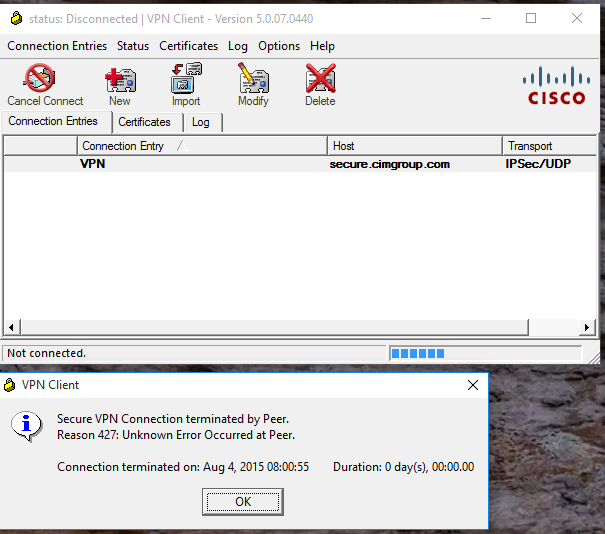
- #Cisco vpn client 5.0.07 sharing connection how to#
- #Cisco vpn client 5.0.07 sharing connection software#
- #Cisco vpn client 5.0.07 sharing connection series#
Choose Configuration > Remote Access VPN > Network (Client) Access > Group Policy and select the Group Policy in which you wish to enable local LAN access.


Configure the ASA via the ASDM or Configure the ASA via the CLI.Configure Local LAN Access for VPN Clients or the An圜onnect Secure Mobility ClientĬomplete these tasks in order to allow Cisco VPN Clients or Cisco An圜onnect Secure Mobility Clients access to their local LAN while connected to the ASA: See the Troubleshoot section of this document for more information as well as workarounds for this situation. However, you can browse or print by IP address. Note: When the client is connected and configured for local LAN access, you cannot print or browse by name on the local LAN. Instead, the ASA supplies a default network of 0.0.0.0/255.255.255.255, which is understood to mean the local LAN of the client. Also, unlike the split tunneling scenario, the actual networks in the list do not need to be known. However, instead of defining which networks should be encrypted, the access list in this case defines which networks should not be encrypted. For example, a client that is allowed local LAN access while connected to the ASA from home is able to print to its own printer but not to access the Internet without first sending the traffic over the tunnel.Īn access list is used in order to allow local LAN access in much the same way that split tunneling is configured on the ASA. Unlike a classic split tunneling scenario in which all Internet traffic is sent unencrypted, when you enable local LAN access for VPN clients, it permits those clients to communicate unencrypted with only devices on the network on which they are located. The client is located on a typical Small Office / Home Office (SOHO) network and connects across the Internet to the main office. If your network is live, make sure that you understand the potential impact of any command. All of the devices used in this document started with a cleared (default) configuration. The information in this document was created from the devices in a specific lab environment.

Cisco An圜onnect Secure Mobility Client Version 2.Cisco Adaptive Security Device Manager (ASDM) Version 7.1(6).
#Cisco vpn client 5.0.07 sharing connection software#
The information in this document is based on these software and hardware versions: Refer to ASA 8.x VPN Access with the An圜onnect SSL VPN Client Configuration Example for the Cisco An圜onnect Secure Mobility Client if one is not already configured. Refer to PIX/ASA 7.x as a Remote VPN Server using ASDM Configuration Example for the Cisco VPN Client if one is not already configured. This document assumes that a functional remote access VPN configuration already exists on the ASA.
#Cisco vpn client 5.0.07 sharing connection how to#
Refer to PIX/ASA 7.x: Allow Split Tunneling for VPN Clients on the ASA Configuration Example for information on how to configure split tunneling on the ASA. Note: This is not a configuration for split tunneling, where the client has unencrypted access to the Internet while connected to the ASA or PIX. If it is permitted, traffic destined for the Internet is still tunneled to the ASA. This configuration allows Cisco VPN Clients or the Cisco An圜onnect Secure Mobility Client secure access to corporate resources via IPsec, Secure Sockets Layer (SSL), or Internet Key Exchange Version 2 (IKEv2) and still gives the client the ability to carry out activities such as printing where the client is located.
#Cisco vpn client 5.0.07 sharing connection series#
This document describes how to allow the Cisco VPN Client or the Cisco An圜onnect Secure Mobility Client to only access their local LAN while tunneled into a Cisco Adaptive Security Appliance (ASA) 5500 Series or the ASA 5500-X Series.


 0 kommentar(er)
0 kommentar(er)
